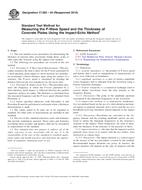Potřebujeme váš souhlas k využití jednotlivých dat, aby se vám mimo jiné mohly ukazovat informace týkající se vašich zájmů. Souhlas udělíte kliknutím na tlačítko „OK“.
ASTM C1383-04(2010)
Standard Test Method for Measuring the P-Wave Speed and the Thickness of Concrete Plates Using the Impact-Echo Method
Automaticky přeložený název:
Standardní zkušební metoda pro měření P-Wave Speed a tloušťka betonového desky Použití Impact-Echo metody
NORMA vydána dne 15.12.2010
Informace o normě:
Označení normy: ASTM C1383-04(2010)
Poznámka: NEPLATNÁ
Datum vydání normy: 15.12.2010
Kód zboží: NS-10960
Počet stran: 11
Přibližná hmotnost: 33 g (0.07 liber)
Země: Americká technická norma
Kategorie: Technické normy ASTM
Anotace textu normy ASTM C1383-04(2010) :
Keywords:
concrete plate, impact-echo, nondestructive testing, P-wave speed, thickness measurement, Impact-echo method, P-wave speed, Thickness--concrete, Concrete, Concrete plates, ICS Number Code 91.100.30 (Concrete and concrete products)
Doplňující informace
| Significance and Use | ||||||
|
This test method may be used as a substitute for, or in conjunction with, coring to determine the thickness of slabs, pavements, decks, walls, or other plate structures. There is a certain level of systematic error in the calculated thickness due to the discrete nature of the digital records that are used. The absolute systematic error depends on the plate thickness, the sampling interval, and the sampling period. Because the wave speed can vary from point-to-point in the structure due to differences in concrete age or batch-to-batch variability, the wave speed is measured (Procedure A) at each point where a thickness determination (Procedure B) is required. The maximum and minimum thickness that can be measured is limited by the details of the testing apparatus (transducer response characteristics and the specific impactor). The limits shall be specified by manufacturer of the apparatus, and the apparatus shall not be used beyond these limits. If test equipment is assembled by the user, thickness limitations shall be established and documented. This test method is not applicable to plate structures with overlays, such as a concrete bridge deck with an asphalt or portland cement concrete overlay. The method is based on the assumption that the concrete plate has the same P-wave speed throughout its depth. Procedure A is performed on concrete that is air dry as high surface moisture content may affect the results. Procedure B is applicable to a concrete plate resting on a subgrade of soil, gravel, permeable asphalt concrete, or lean portland cement concrete provided there is sufficient difference in acoustic impedance between the concrete and subgrade or there are enough air voids at the interface to produce measurable reflections. If these conditions are not satisfied, the waveform will be of low amplitude and the amplitude spectrum will not include a dominant peak at the frequency corresponding to the thickness (Eq 2). If the interface between the concrete and subgrade is rough, the amplitude spectrum will have a rounded peak instead of a sharp peak associated with a flat surface. The procedures described are not influenced by traffic noise or low frequency structural vibrations set up by normal movement of traffic across a structure. The procedures are not applicable in the presence of mechanical noise created by equipment impacting (jack hammers, sounding with a hammer, mechanical sweepers, and so forth) on the structure. Procedure A is not applicable in the presence of high amplitude electrical noise, such as may produced by a generator or some other source, that is transmitted to the data-acquisition system. |
||||||
| 1. Scope | ||||||
|
1.1 This test method covers procedures for determining the thickness of concrete slabs, pavements, bridge decks, walls, or other plate-like structure using the impact-echo method. 1.2 The following two procedures are covered in this test method: 1.2.1 Procedure A: P-Wave Speed Measurement—This procedure measures the time it takes for the P-wave generated by a short-duration, point impact to travel between two transducers positioned a known distance apart along the surface of a structure. The P-wave speed is calculated by dividing the distance between the two transducers by the travel time. 1.2.2 Procedure B: Impact-Echo Test—This procedure measures the frequency at which the P-wave generated by a short-duration, point impact is reflected between the parallel (opposite) surfaces of a plate. The thickness is calculated from this measured frequency and the P-wave speed obtained from Procedure A. 1.2.3 Unless specified otherwise, both Procedure A and Procedure B must be performed at each point where a thickness determination is made. 1.3 The values stated in SI units are to be regarded as standard. No other units of measurement are included in this standard. 1.4 The text of this standard references notes and footnotes that provide explanatory material. These notes and footnotes (excluding those in tables and figures) shall not be considered as requirements of the standard. 1.5 This standard does not purport to address all of the safety concerns, if any, associated with its use. It is the responsibility of the user of this standard to establish appropriate safety and health practices and determine the applicability of regulatory limitations prior to use. |
||||||
| 2. Referenced Documents | ||||||
|
Odebírejte informace o nově vydaných normách ZDARMA:
Chcete pravidelně odebírat informace o nově vycházejících normách z celého světa a to zcela zdarma?
Přihlašte se k odběru. Vše je velice jednoduché a absolutně ZDARMA.
Na výběr máte vydavatele z celého světa.




 Cookies
Cookies
